A Report on Communication Strategies within Tesco's Business Model
VerifiedAdded on 2020/06/06
|13
|3586
|51
Report
AI Summary
This report provides a comprehensive analysis of communication strategies within Tesco's business environment. It begins by outlining the communication needs of both internal and external stakeholders, including employees, managers, customers, and suppliers. The report then explores various communication models, such as the chain model and the star model, and assesses the effectiveness of different communication systems, including emails, social media, and presentations. Factors influencing the choice of communication media, such as the audience and the message complexity, are also discussed. Furthermore, the report emphasizes the importance of correct grammar, sentence structure, and punctuation in business communications. It also covers strategies for planning and structuring communication media, overcoming barriers to communication, and utilizing communication theories and body language. The report concludes with a discussion of proofreading techniques and the importance of tailoring communication to the purpose and audience, covering formats, layout, and style. The report also details agreed business practices, appropriate style and content, and the importance of clear and concise written communication within Tesco's business operations.
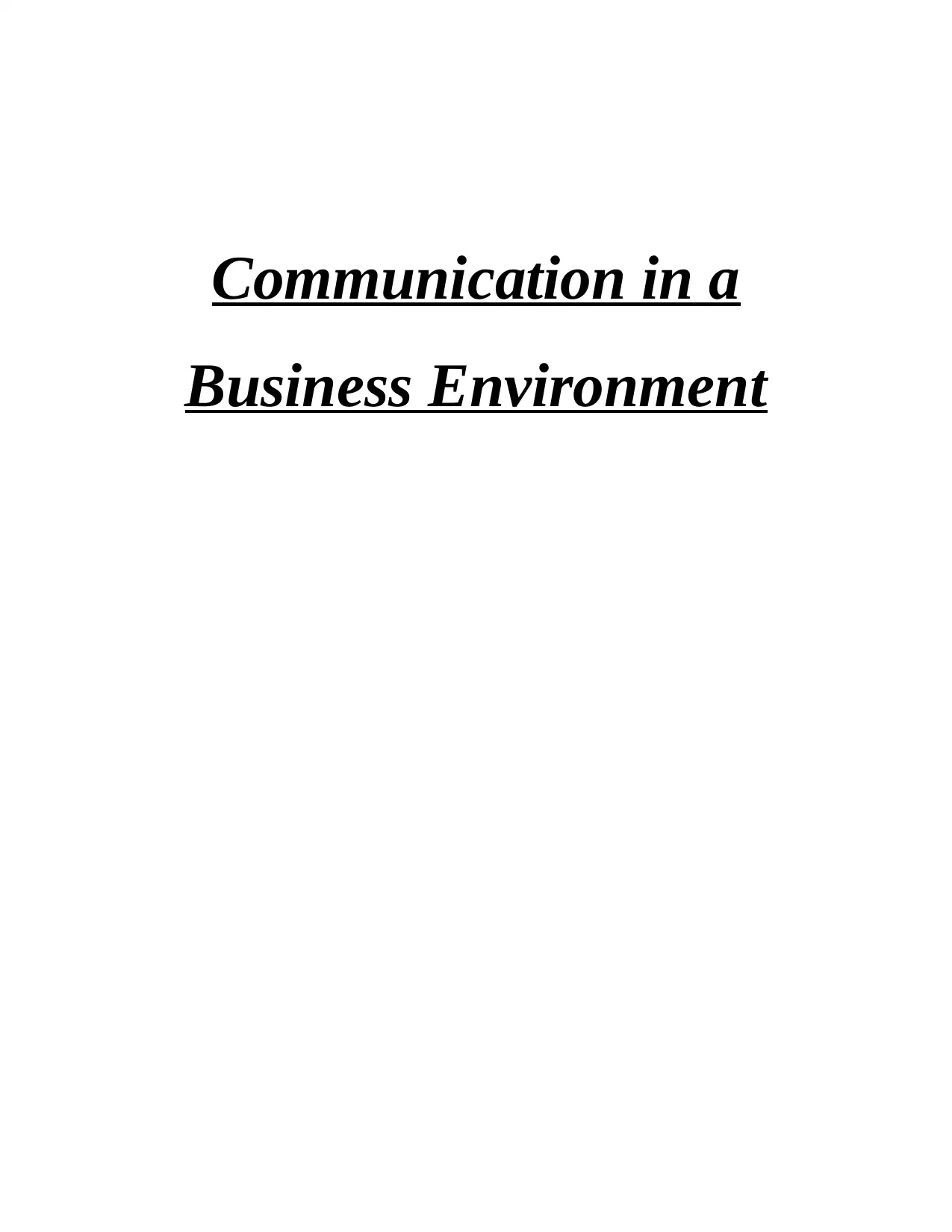
Communication in a
Business Environment
Business Environment
Paraphrase This Document
Need a fresh take? Get an instant paraphrase of this document with our AI Paraphraser
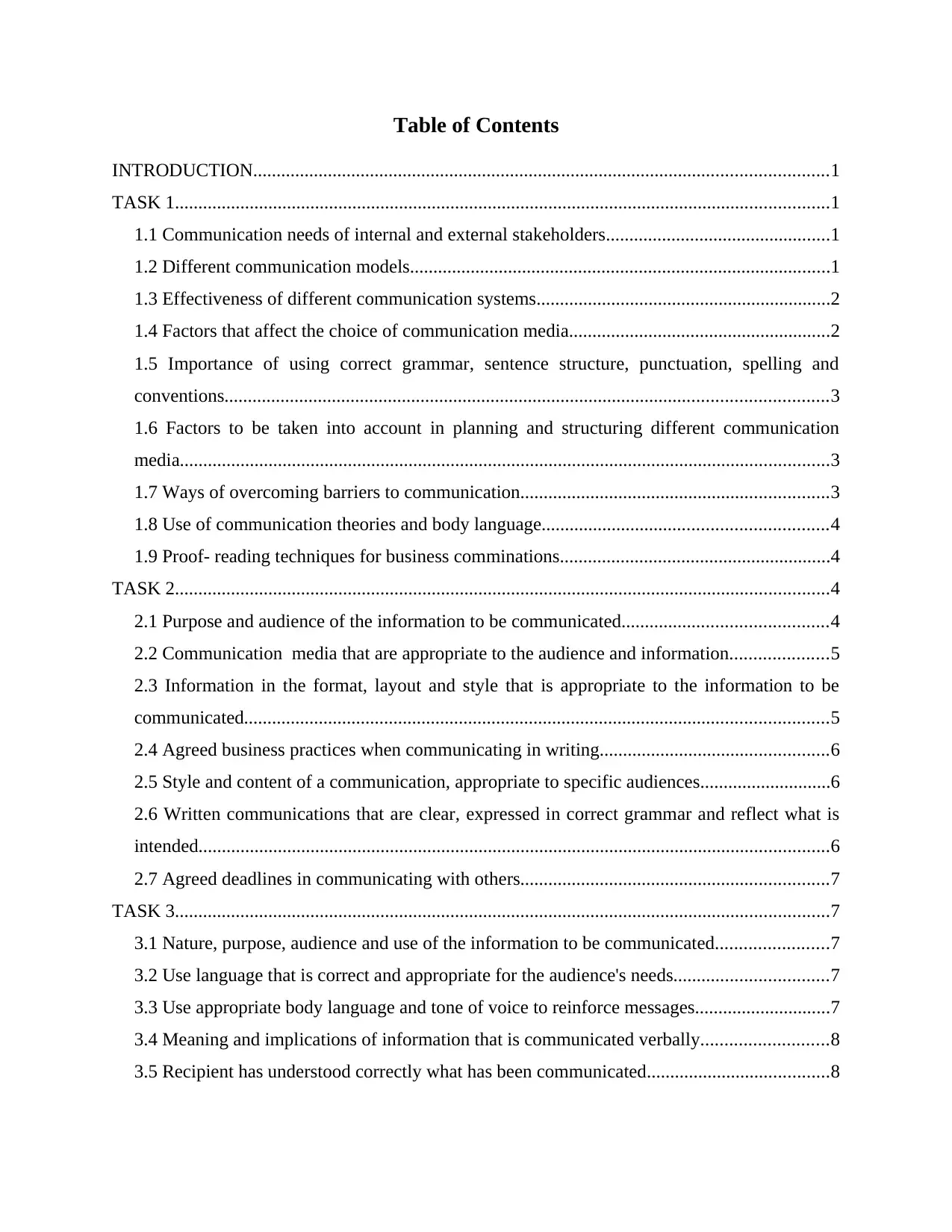
Table of Contents
INTRODUCTION...........................................................................................................................1
TASK 1............................................................................................................................................1
1.1 Communication needs of internal and external stakeholders................................................1
1.2 Different communication models..........................................................................................1
1.3 Effectiveness of different communication systems...............................................................2
1.4 Factors that affect the choice of communication media........................................................2
1.5 Importance of using correct grammar, sentence structure, punctuation, spelling and
conventions.................................................................................................................................3
1.6 Factors to be taken into account in planning and structuring different communication
media...........................................................................................................................................3
1.7 Ways of overcoming barriers to communication..................................................................3
1.8 Use of communication theories and body language.............................................................4
1.9 Proof- reading techniques for business comminations..........................................................4
TASK 2............................................................................................................................................4
2.1 Purpose and audience of the information to be communicated............................................4
2.2 Communication media that are appropriate to the audience and information.....................5
2.3 Information in the format, layout and style that is appropriate to the information to be
communicated.............................................................................................................................5
2.4 Agreed business practices when communicating in writing.................................................6
2.5 Style and content of a communication, appropriate to specific audiences............................6
2.6 Written communications that are clear, expressed in correct grammar and reflect what is
intended.......................................................................................................................................6
2.7 Agreed deadlines in communicating with others..................................................................7
TASK 3............................................................................................................................................7
3.1 Nature, purpose, audience and use of the information to be communicated........................7
3.2 Use language that is correct and appropriate for the audience's needs.................................7
3.3 Use appropriate body language and tone of voice to reinforce messages.............................7
3.4 Meaning and implications of information that is communicated verbally...........................8
3.5 Recipient has understood correctly what has been communicated.......................................8
INTRODUCTION...........................................................................................................................1
TASK 1............................................................................................................................................1
1.1 Communication needs of internal and external stakeholders................................................1
1.2 Different communication models..........................................................................................1
1.3 Effectiveness of different communication systems...............................................................2
1.4 Factors that affect the choice of communication media........................................................2
1.5 Importance of using correct grammar, sentence structure, punctuation, spelling and
conventions.................................................................................................................................3
1.6 Factors to be taken into account in planning and structuring different communication
media...........................................................................................................................................3
1.7 Ways of overcoming barriers to communication..................................................................3
1.8 Use of communication theories and body language.............................................................4
1.9 Proof- reading techniques for business comminations..........................................................4
TASK 2............................................................................................................................................4
2.1 Purpose and audience of the information to be communicated............................................4
2.2 Communication media that are appropriate to the audience and information.....................5
2.3 Information in the format, layout and style that is appropriate to the information to be
communicated.............................................................................................................................5
2.4 Agreed business practices when communicating in writing.................................................6
2.5 Style and content of a communication, appropriate to specific audiences............................6
2.6 Written communications that are clear, expressed in correct grammar and reflect what is
intended.......................................................................................................................................6
2.7 Agreed deadlines in communicating with others..................................................................7
TASK 3............................................................................................................................................7
3.1 Nature, purpose, audience and use of the information to be communicated........................7
3.2 Use language that is correct and appropriate for the audience's needs.................................7
3.3 Use appropriate body language and tone of voice to reinforce messages.............................7
3.4 Meaning and implications of information that is communicated verbally...........................8
3.5 Recipient has understood correctly what has been communicated.......................................8
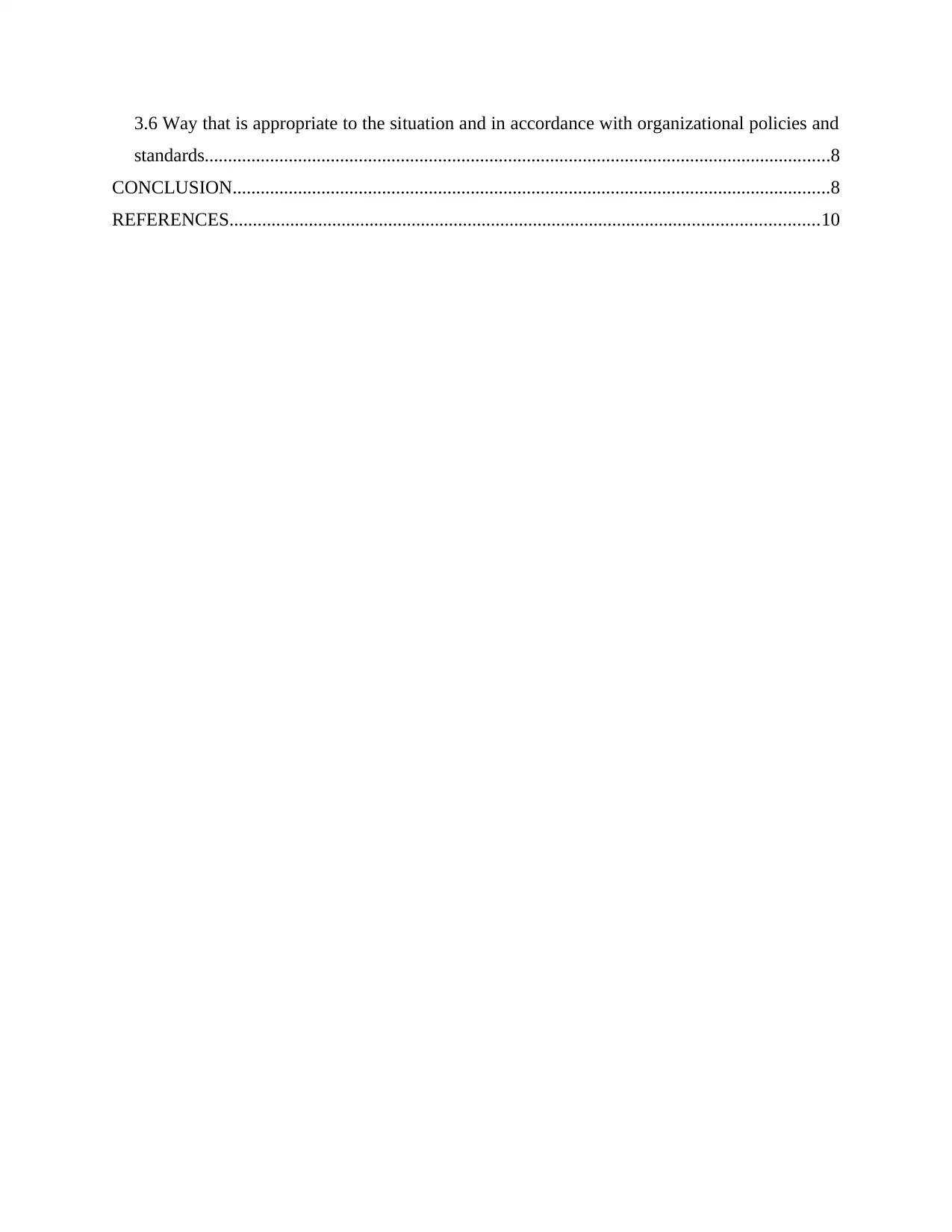
3.6 Way that is appropriate to the situation and in accordance with organizational policies and
standards......................................................................................................................................8
CONCLUSION................................................................................................................................8
REFERENCES..............................................................................................................................10
standards......................................................................................................................................8
CONCLUSION................................................................................................................................8
REFERENCES..............................................................................................................................10
⊘ This is a preview!⊘
Do you want full access?
Subscribe today to unlock all pages.

Trusted by 1+ million students worldwide
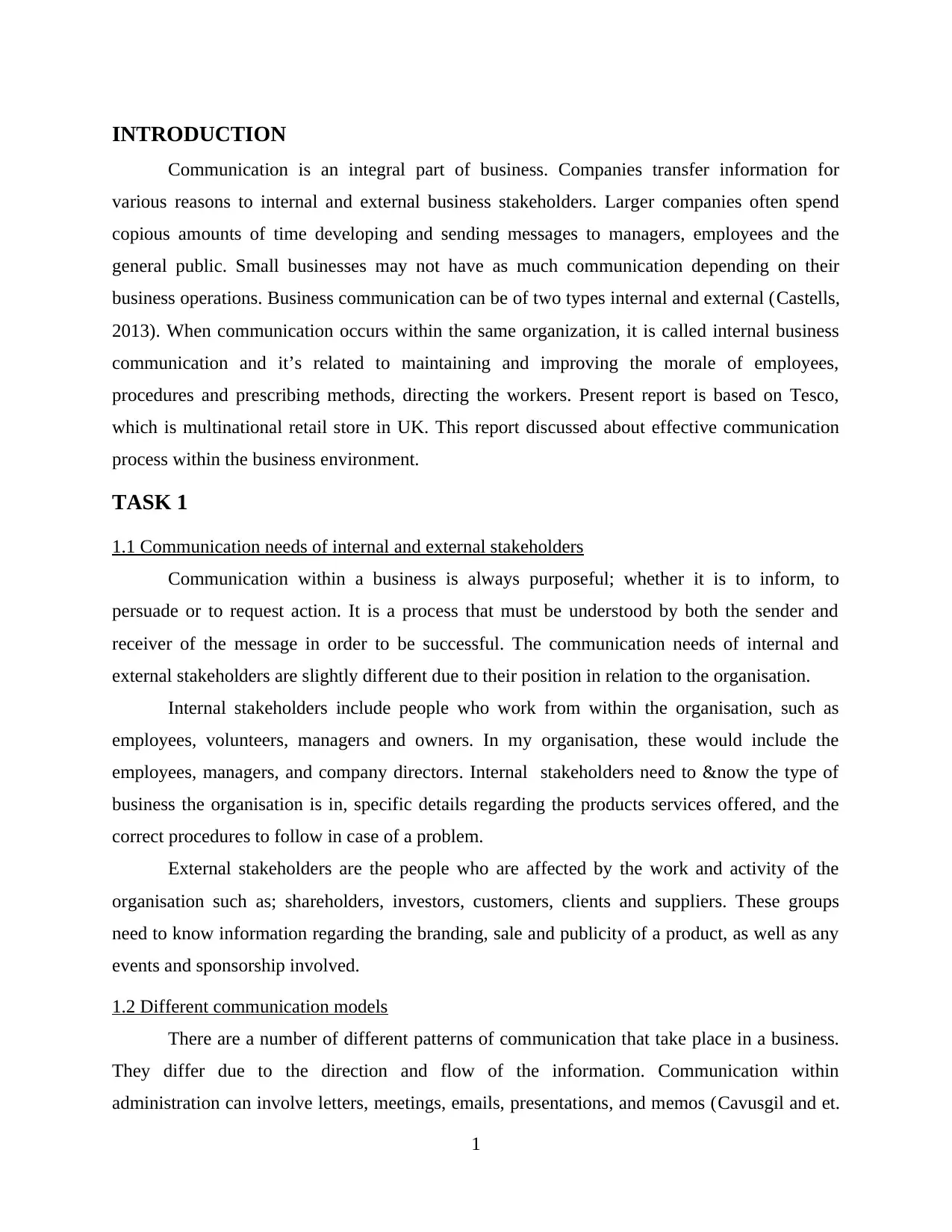
INTRODUCTION
Communication is an integral part of business. Companies transfer information for
various reasons to internal and external business stakeholders. Larger companies often spend
copious amounts of time developing and sending messages to managers, employees and the
general public. Small businesses may not have as much communication depending on their
business operations. Business communication can be of two types internal and external (Castells,
2013). When communication occurs within the same organization, it is called internal business
communication and it’s related to maintaining and improving the morale of employees,
procedures and prescribing methods, directing the workers. Present report is based on Tesco,
which is multinational retail store in UK. This report discussed about effective communication
process within the business environment.
TASK 1
1.1 Communication needs of internal and external stakeholders
Communication within a business is always purposeful; whether it is to inform, to
persuade or to request action. It is a process that must be understood by both the sender and
receiver of the message in order to be successful. The communication needs of internal and
external stakeholders are slightly different due to their position in relation to the organisation.
Internal stakeholders include people who work from within the organisation, such as
employees, volunteers, managers and owners. In my organisation, these would include the
employees, managers, and company directors. Internal stakeholders need to &now the type of
business the organisation is in, specific details regarding the products services offered, and the
correct procedures to follow in case of a problem.
External stakeholders are the people who are affected by the work and activity of the
organisation such as; shareholders, investors, customers, clients and suppliers. These groups
need to know information regarding the branding, sale and publicity of a product, as well as any
events and sponsorship involved.
1.2 Different communication models
There are a number of different patterns of communication that take place in a business.
They differ due to the direction and flow of the information. Communication within
administration can involve letters, meetings, emails, presentations, and memos (Cavusgil and et.
1
Communication is an integral part of business. Companies transfer information for
various reasons to internal and external business stakeholders. Larger companies often spend
copious amounts of time developing and sending messages to managers, employees and the
general public. Small businesses may not have as much communication depending on their
business operations. Business communication can be of two types internal and external (Castells,
2013). When communication occurs within the same organization, it is called internal business
communication and it’s related to maintaining and improving the morale of employees,
procedures and prescribing methods, directing the workers. Present report is based on Tesco,
which is multinational retail store in UK. This report discussed about effective communication
process within the business environment.
TASK 1
1.1 Communication needs of internal and external stakeholders
Communication within a business is always purposeful; whether it is to inform, to
persuade or to request action. It is a process that must be understood by both the sender and
receiver of the message in order to be successful. The communication needs of internal and
external stakeholders are slightly different due to their position in relation to the organisation.
Internal stakeholders include people who work from within the organisation, such as
employees, volunteers, managers and owners. In my organisation, these would include the
employees, managers, and company directors. Internal stakeholders need to &now the type of
business the organisation is in, specific details regarding the products services offered, and the
correct procedures to follow in case of a problem.
External stakeholders are the people who are affected by the work and activity of the
organisation such as; shareholders, investors, customers, clients and suppliers. These groups
need to know information regarding the branding, sale and publicity of a product, as well as any
events and sponsorship involved.
1.2 Different communication models
There are a number of different patterns of communication that take place in a business.
They differ due to the direction and flow of the information. Communication within
administration can involve letters, meetings, emails, presentations, and memos (Cavusgil and et.
1
Paraphrase This Document
Need a fresh take? Get an instant paraphrase of this document with our AI Paraphraser
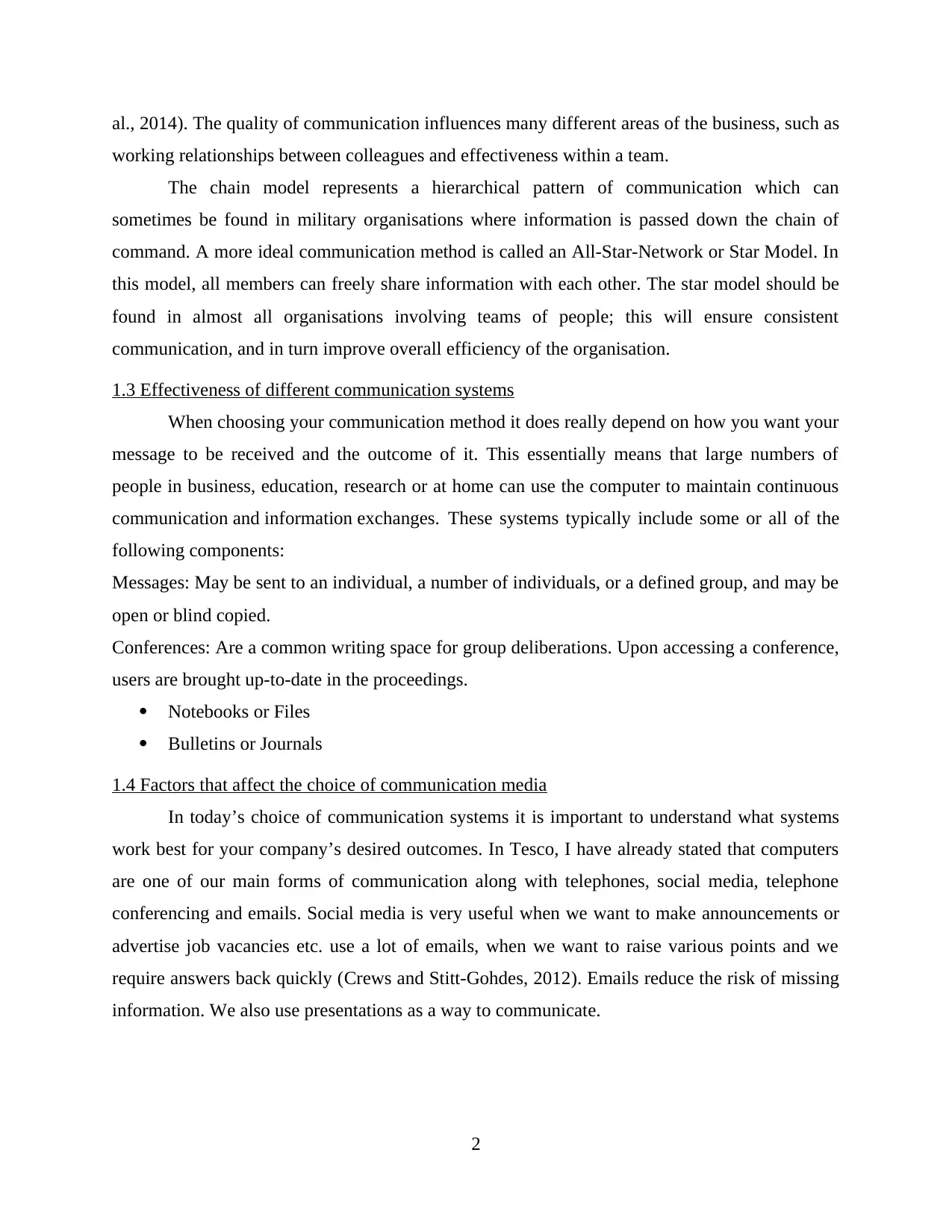
al., 2014). The quality of communication influences many different areas of the business, such as
working relationships between colleagues and effectiveness within a team.
The chain model represents a hierarchical pattern of communication which can
sometimes be found in military organisations where information is passed down the chain of
command. A more ideal communication method is called an All-Star-Network or Star Model. In
this model, all members can freely share information with each other. The star model should be
found in almost all organisations involving teams of people; this will ensure consistent
communication, and in turn improve overall efficiency of the organisation.
1.3 Effectiveness of different communication systems
When choosing your communication method it does really depend on how you want your
message to be received and the outcome of it. This essentially means that large numbers of
people in business, education, research or at home can use the computer to maintain continuous
communication and information exchanges. These systems typically include some or all of the
following components:
Messages: May be sent to an individual, a number of individuals, or a defined group, and may be
open or blind copied.
Conferences: Are a common writing space for group deliberations. Upon accessing a conference,
users are brought up-to-date in the proceedings.
Notebooks or Files
Bulletins or Journals
1.4 Factors that affect the choice of communication media
In today’s choice of communication systems it is important to understand what systems
work best for your company’s desired outcomes. In Tesco, I have already stated that computers
are one of our main forms of communication along with telephones, social media, telephone
conferencing and emails. Social media is very useful when we want to make announcements or
advertise job vacancies etc. use a lot of emails, when we want to raise various points and we
require answers back quickly (Crews and Stitt-Gohdes, 2012). Emails reduce the risk of missing
information. We also use presentations as a way to communicate.
2
working relationships between colleagues and effectiveness within a team.
The chain model represents a hierarchical pattern of communication which can
sometimes be found in military organisations where information is passed down the chain of
command. A more ideal communication method is called an All-Star-Network or Star Model. In
this model, all members can freely share information with each other. The star model should be
found in almost all organisations involving teams of people; this will ensure consistent
communication, and in turn improve overall efficiency of the organisation.
1.3 Effectiveness of different communication systems
When choosing your communication method it does really depend on how you want your
message to be received and the outcome of it. This essentially means that large numbers of
people in business, education, research or at home can use the computer to maintain continuous
communication and information exchanges. These systems typically include some or all of the
following components:
Messages: May be sent to an individual, a number of individuals, or a defined group, and may be
open or blind copied.
Conferences: Are a common writing space for group deliberations. Upon accessing a conference,
users are brought up-to-date in the proceedings.
Notebooks or Files
Bulletins or Journals
1.4 Factors that affect the choice of communication media
In today’s choice of communication systems it is important to understand what systems
work best for your company’s desired outcomes. In Tesco, I have already stated that computers
are one of our main forms of communication along with telephones, social media, telephone
conferencing and emails. Social media is very useful when we want to make announcements or
advertise job vacancies etc. use a lot of emails, when we want to raise various points and we
require answers back quickly (Crews and Stitt-Gohdes, 2012). Emails reduce the risk of missing
information. We also use presentations as a way to communicate.
2
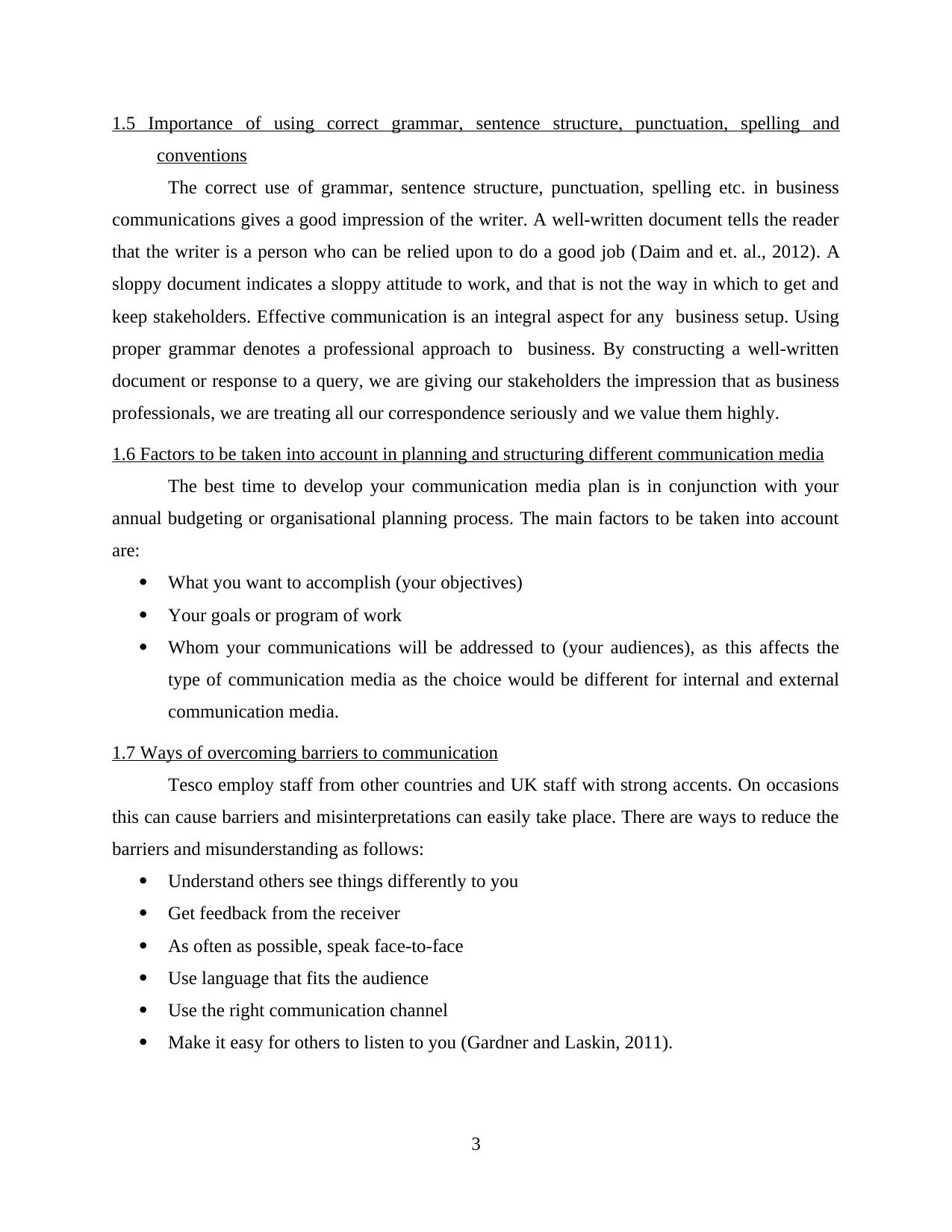
1.5 Importance of using correct grammar, sentence structure, punctuation, spelling and
conventions
The correct use of grammar, sentence structure, punctuation, spelling etc. in business
communications gives a good impression of the writer. A well-written document tells the reader
that the writer is a person who can be relied upon to do a good job (Daim and et. al., 2012). A
sloppy document indicates a sloppy attitude to work, and that is not the way in which to get and
keep stakeholders. Effective communication is an integral aspect for any business setup. Using
proper grammar denotes a professional approach to business. By constructing a well-written
document or response to a query, we are giving our stakeholders the impression that as business
professionals, we are treating all our correspondence seriously and we value them highly.
1.6 Factors to be taken into account in planning and structuring different communication media
The best time to develop your communication media plan is in conjunction with your
annual budgeting or organisational planning process. The main factors to be taken into account
are:
What you want to accomplish (your objectives)
Your goals or program of work
Whom your communications will be addressed to (your audiences), as this affects the
type of communication media as the choice would be different for internal and external
communication media.
1.7 Ways of overcoming barriers to communication
Tesco employ staff from other countries and UK staff with strong accents. On occasions
this can cause barriers and misinterpretations can easily take place. There are ways to reduce the
barriers and misunderstanding as follows:
Understand others see things differently to you
Get feedback from the receiver
As often as possible, speak face-to-face
Use language that fits the audience
Use the right communication channel
Make it easy for others to listen to you (Gardner and Laskin, 2011).
3
conventions
The correct use of grammar, sentence structure, punctuation, spelling etc. in business
communications gives a good impression of the writer. A well-written document tells the reader
that the writer is a person who can be relied upon to do a good job (Daim and et. al., 2012). A
sloppy document indicates a sloppy attitude to work, and that is not the way in which to get and
keep stakeholders. Effective communication is an integral aspect for any business setup. Using
proper grammar denotes a professional approach to business. By constructing a well-written
document or response to a query, we are giving our stakeholders the impression that as business
professionals, we are treating all our correspondence seriously and we value them highly.
1.6 Factors to be taken into account in planning and structuring different communication media
The best time to develop your communication media plan is in conjunction with your
annual budgeting or organisational planning process. The main factors to be taken into account
are:
What you want to accomplish (your objectives)
Your goals or program of work
Whom your communications will be addressed to (your audiences), as this affects the
type of communication media as the choice would be different for internal and external
communication media.
1.7 Ways of overcoming barriers to communication
Tesco employ staff from other countries and UK staff with strong accents. On occasions
this can cause barriers and misinterpretations can easily take place. There are ways to reduce the
barriers and misunderstanding as follows:
Understand others see things differently to you
Get feedback from the receiver
As often as possible, speak face-to-face
Use language that fits the audience
Use the right communication channel
Make it easy for others to listen to you (Gardner and Laskin, 2011).
3
⊘ This is a preview!⊘
Do you want full access?
Subscribe today to unlock all pages.

Trusted by 1+ million students worldwide
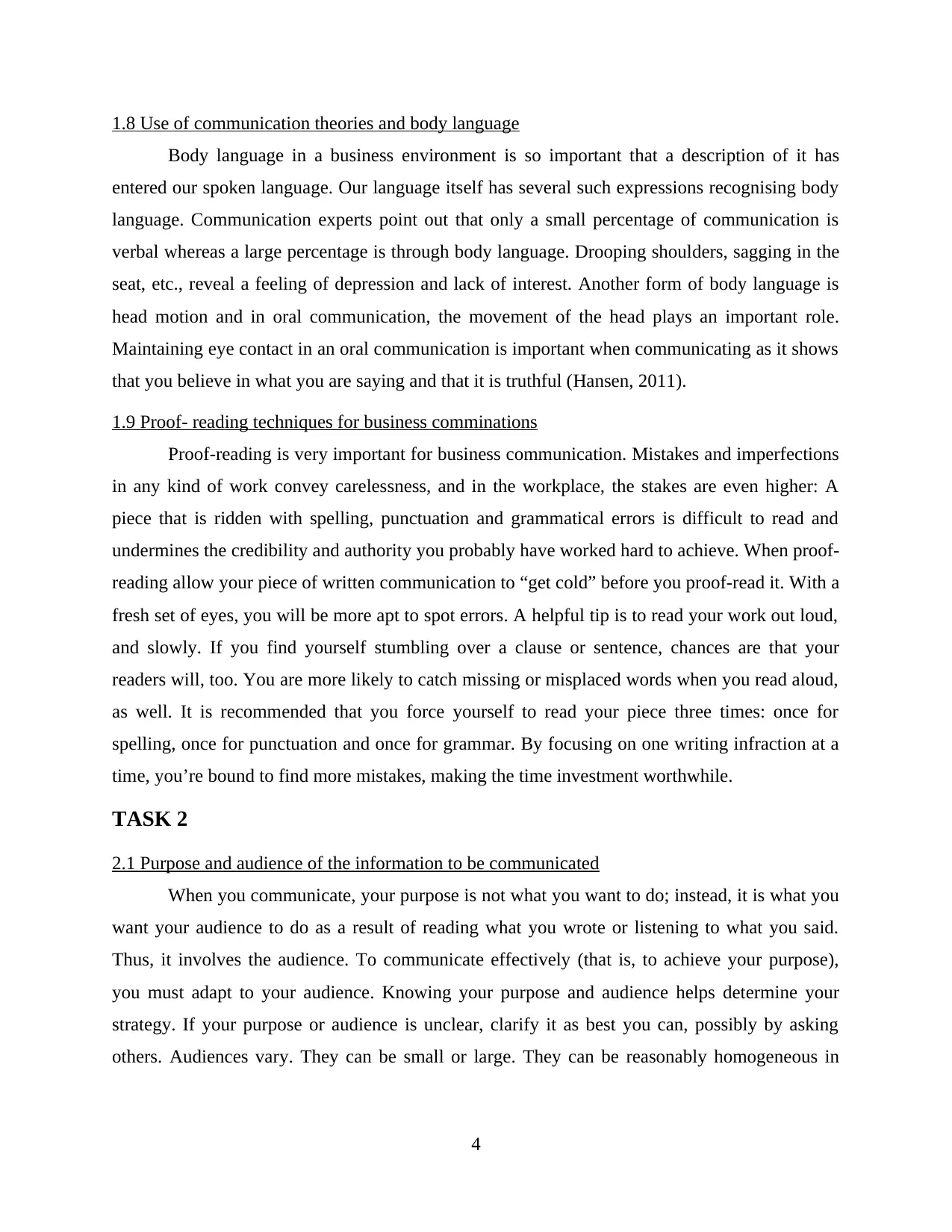
1.8 Use of communication theories and body language
Body language in a business environment is so important that a description of it has
entered our spoken language. Our language itself has several such expressions recognising body
language. Communication experts point out that only a small percentage of communication is
verbal whereas a large percentage is through body language. Drooping shoulders, sagging in the
seat, etc., reveal a feeling of depression and lack of interest. Another form of body language is
head motion and in oral communication, the movement of the head plays an important role.
Maintaining eye contact in an oral communication is important when communicating as it shows
that you believe in what you are saying and that it is truthful (Hansen, 2011).
1.9 Proof- reading techniques for business comminations
Proof-reading is very important for business communication. Mistakes and imperfections
in any kind of work convey carelessness, and in the workplace, the stakes are even higher: A
piece that is ridden with spelling, punctuation and grammatical errors is difficult to read and
undermines the credibility and authority you probably have worked hard to achieve. When proof-
reading allow your piece of written communication to “get cold” before you proof-read it. With a
fresh set of eyes, you will be more apt to spot errors. A helpful tip is to read your work out loud,
and slowly. If you find yourself stumbling over a clause or sentence, chances are that your
readers will, too. You are more likely to catch missing or misplaced words when you read aloud,
as well. It is recommended that you force yourself to read your piece three times: once for
spelling, once for punctuation and once for grammar. By focusing on one writing infraction at a
time, you’re bound to find more mistakes, making the time investment worthwhile.
TASK 2
2.1 Purpose and audience of the information to be communicated
When you communicate, your purpose is not what you want to do; instead, it is what you
want your audience to do as a result of reading what you wrote or listening to what you said.
Thus, it involves the audience. To communicate effectively (that is, to achieve your purpose),
you must adapt to your audience. Knowing your purpose and audience helps determine your
strategy. If your purpose or audience is unclear, clarify it as best you can, possibly by asking
others. Audiences vary. They can be small or large. They can be reasonably homogeneous in
4
Body language in a business environment is so important that a description of it has
entered our spoken language. Our language itself has several such expressions recognising body
language. Communication experts point out that only a small percentage of communication is
verbal whereas a large percentage is through body language. Drooping shoulders, sagging in the
seat, etc., reveal a feeling of depression and lack of interest. Another form of body language is
head motion and in oral communication, the movement of the head plays an important role.
Maintaining eye contact in an oral communication is important when communicating as it shows
that you believe in what you are saying and that it is truthful (Hansen, 2011).
1.9 Proof- reading techniques for business comminations
Proof-reading is very important for business communication. Mistakes and imperfections
in any kind of work convey carelessness, and in the workplace, the stakes are even higher: A
piece that is ridden with spelling, punctuation and grammatical errors is difficult to read and
undermines the credibility and authority you probably have worked hard to achieve. When proof-
reading allow your piece of written communication to “get cold” before you proof-read it. With a
fresh set of eyes, you will be more apt to spot errors. A helpful tip is to read your work out loud,
and slowly. If you find yourself stumbling over a clause or sentence, chances are that your
readers will, too. You are more likely to catch missing or misplaced words when you read aloud,
as well. It is recommended that you force yourself to read your piece three times: once for
spelling, once for punctuation and once for grammar. By focusing on one writing infraction at a
time, you’re bound to find more mistakes, making the time investment worthwhile.
TASK 2
2.1 Purpose and audience of the information to be communicated
When you communicate, your purpose is not what you want to do; instead, it is what you
want your audience to do as a result of reading what you wrote or listening to what you said.
Thus, it involves the audience. To communicate effectively (that is, to achieve your purpose),
you must adapt to your audience. Knowing your purpose and audience helps determine your
strategy. If your purpose or audience is unclear, clarify it as best you can, possibly by asking
others. Audiences vary. They can be small or large. They can be reasonably homogeneous in
4
Paraphrase This Document
Need a fresh take? Get an instant paraphrase of this document with our AI Paraphraser
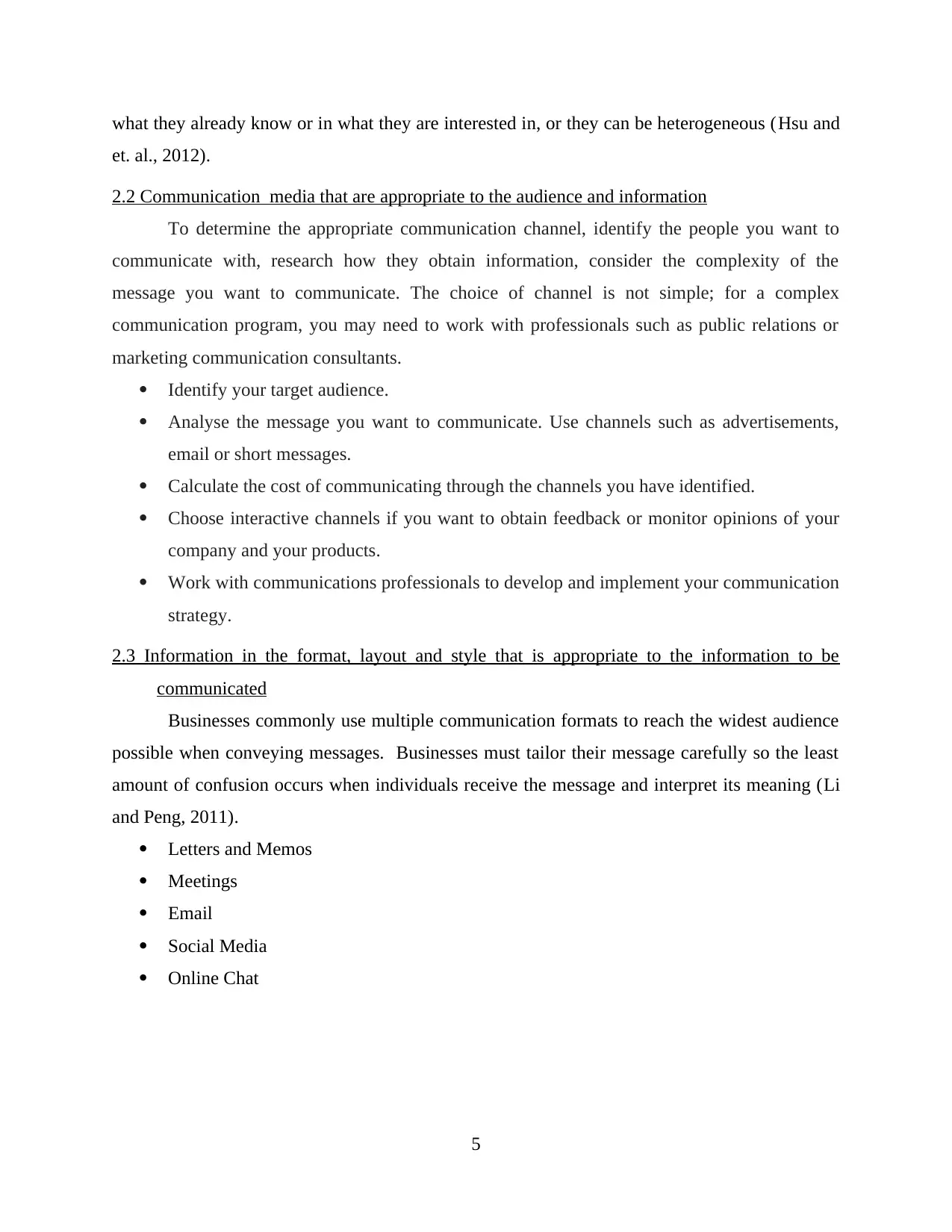
what they already know or in what they are interested in, or they can be heterogeneous (Hsu and
et. al., 2012).
2.2 Communication media that are appropriate to the audience and information
To determine the appropriate communication channel, identify the people you want to
communicate with, research how they obtain information, consider the complexity of the
message you want to communicate. The choice of channel is not simple; for a complex
communication program, you may need to work with professionals such as public relations or
marketing communication consultants.
Identify your target audience.
Analyse the message you want to communicate. Use channels such as advertisements,
email or short messages.
Calculate the cost of communicating through the channels you have identified.
Choose interactive channels if you want to obtain feedback or monitor opinions of your
company and your products.
Work with communications professionals to develop and implement your communication
strategy.
2.3 Information in the format, layout and style that is appropriate to the information to be
communicated
Businesses commonly use multiple communication formats to reach the widest audience
possible when conveying messages. Businesses must tailor their message carefully so the least
amount of confusion occurs when individuals receive the message and interpret its meaning (Li
and Peng, 2011).
Letters and Memos
Meetings
Email
Social Media
Online Chat
5
et. al., 2012).
2.2 Communication media that are appropriate to the audience and information
To determine the appropriate communication channel, identify the people you want to
communicate with, research how they obtain information, consider the complexity of the
message you want to communicate. The choice of channel is not simple; for a complex
communication program, you may need to work with professionals such as public relations or
marketing communication consultants.
Identify your target audience.
Analyse the message you want to communicate. Use channels such as advertisements,
email or short messages.
Calculate the cost of communicating through the channels you have identified.
Choose interactive channels if you want to obtain feedback or monitor opinions of your
company and your products.
Work with communications professionals to develop and implement your communication
strategy.
2.3 Information in the format, layout and style that is appropriate to the information to be
communicated
Businesses commonly use multiple communication formats to reach the widest audience
possible when conveying messages. Businesses must tailor their message carefully so the least
amount of confusion occurs when individuals receive the message and interpret its meaning (Li
and Peng, 2011).
Letters and Memos
Meetings
Social Media
Online Chat
5
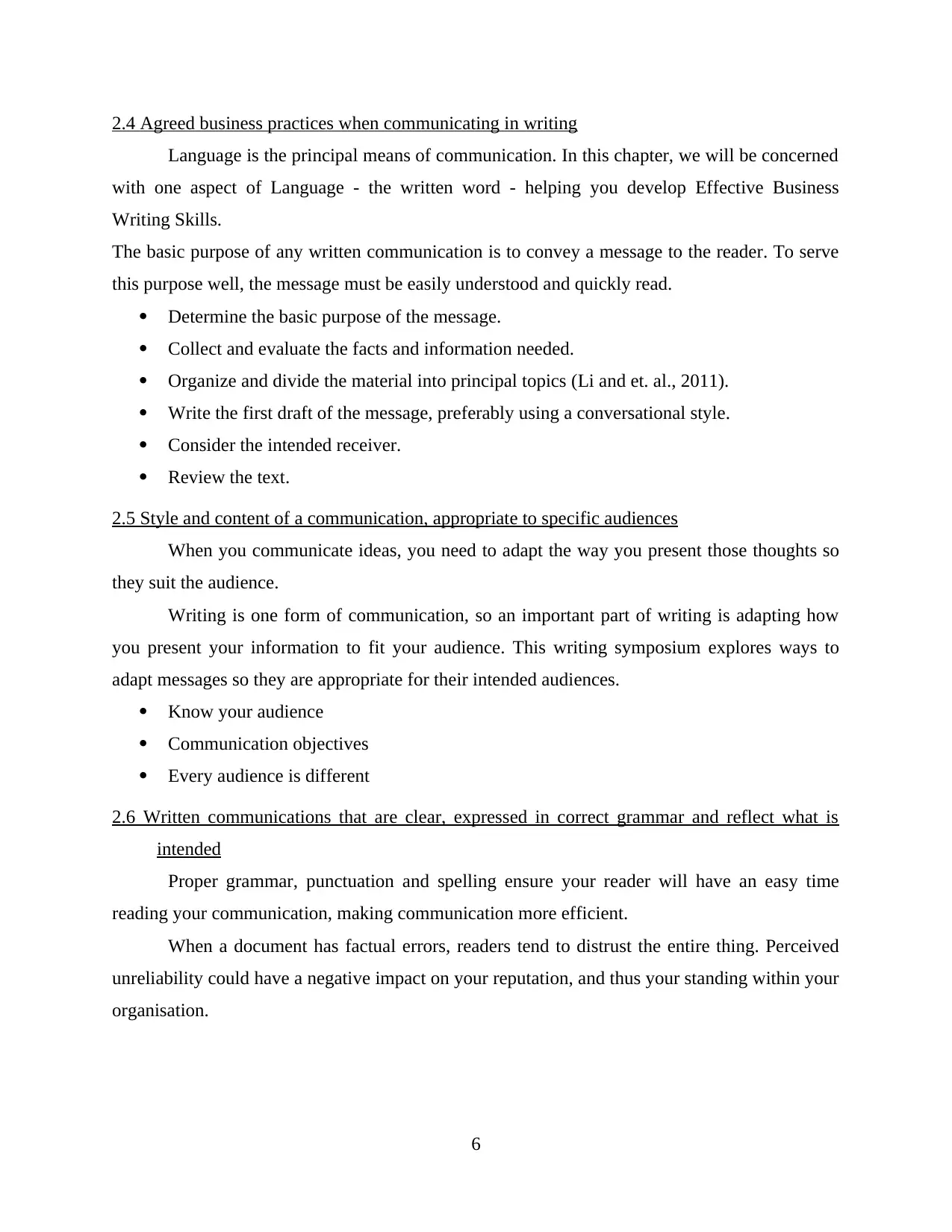
2.4 Agreed business practices when communicating in writing
Language is the principal means of communication. In this chapter, we will be concerned
with one aspect of Language - the written word - helping you develop Effective Business
Writing Skills.
The basic purpose of any written communication is to convey a message to the reader. To serve
this purpose well, the message must be easily understood and quickly read.
Determine the basic purpose of the message.
Collect and evaluate the facts and information needed.
Organize and divide the material into principal topics (Li and et. al., 2011).
Write the first draft of the message, preferably using a conversational style.
Consider the intended receiver.
Review the text.
2.5 Style and content of a communication, appropriate to specific audiences
When you communicate ideas, you need to adapt the way you present those thoughts so
they suit the audience.
Writing is one form of communication, so an important part of writing is adapting how
you present your information to fit your audience. This writing symposium explores ways to
adapt messages so they are appropriate for their intended audiences.
Know your audience
Communication objectives
Every audience is different
2.6 Written communications that are clear, expressed in correct grammar and reflect what is
intended
Proper grammar, punctuation and spelling ensure your reader will have an easy time
reading your communication, making communication more efficient.
When a document has factual errors, readers tend to distrust the entire thing. Perceived
unreliability could have a negative impact on your reputation, and thus your standing within your
organisation.
6
Language is the principal means of communication. In this chapter, we will be concerned
with one aspect of Language - the written word - helping you develop Effective Business
Writing Skills.
The basic purpose of any written communication is to convey a message to the reader. To serve
this purpose well, the message must be easily understood and quickly read.
Determine the basic purpose of the message.
Collect and evaluate the facts and information needed.
Organize and divide the material into principal topics (Li and et. al., 2011).
Write the first draft of the message, preferably using a conversational style.
Consider the intended receiver.
Review the text.
2.5 Style and content of a communication, appropriate to specific audiences
When you communicate ideas, you need to adapt the way you present those thoughts so
they suit the audience.
Writing is one form of communication, so an important part of writing is adapting how
you present your information to fit your audience. This writing symposium explores ways to
adapt messages so they are appropriate for their intended audiences.
Know your audience
Communication objectives
Every audience is different
2.6 Written communications that are clear, expressed in correct grammar and reflect what is
intended
Proper grammar, punctuation and spelling ensure your reader will have an easy time
reading your communication, making communication more efficient.
When a document has factual errors, readers tend to distrust the entire thing. Perceived
unreliability could have a negative impact on your reputation, and thus your standing within your
organisation.
6
⊘ This is a preview!⊘
Do you want full access?
Subscribe today to unlock all pages.

Trusted by 1+ million students worldwide
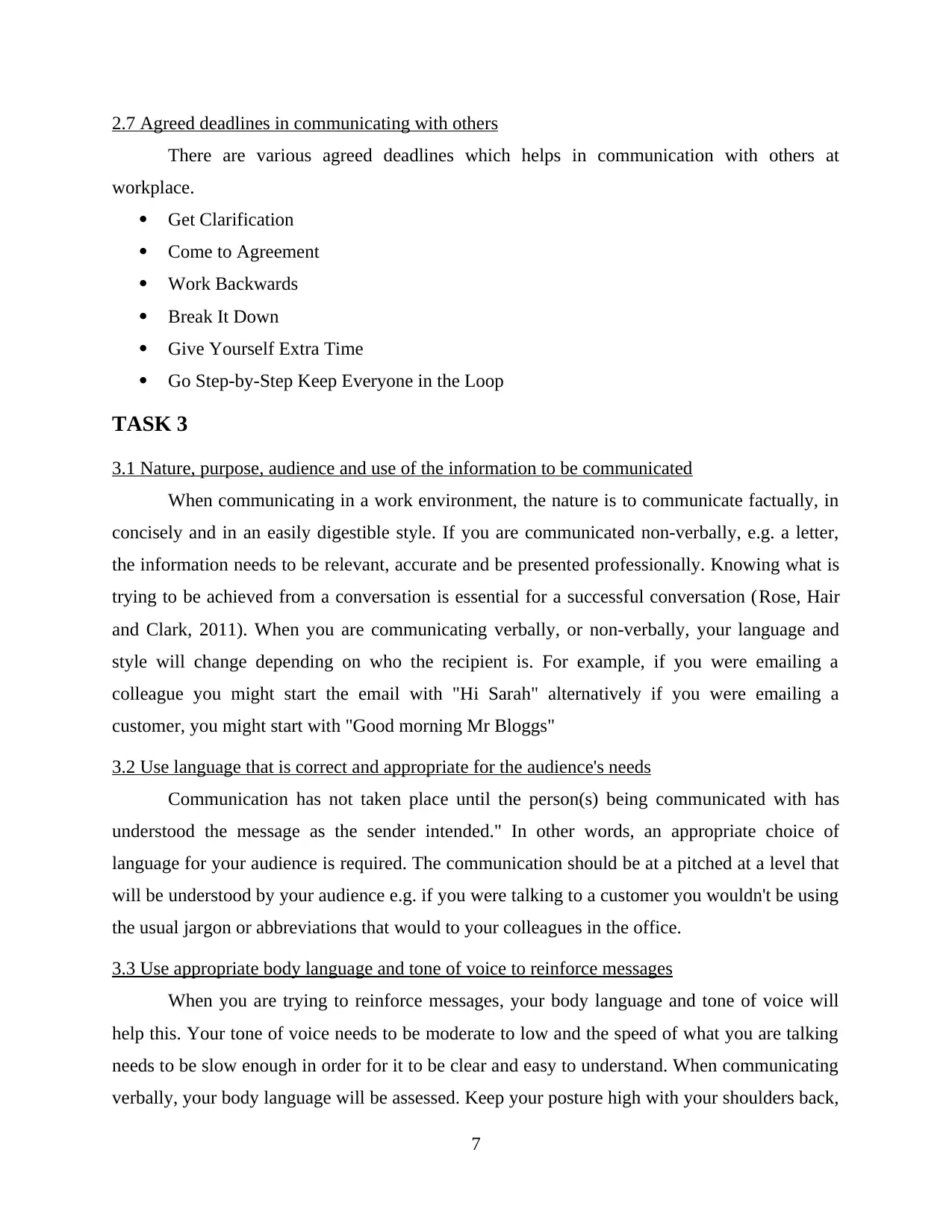
2.7 Agreed deadlines in communicating with others
There are various agreed deadlines which helps in communication with others at
workplace.
Get Clarification
Come to Agreement
Work Backwards
Break It Down
Give Yourself Extra Time
Go Step-by-Step Keep Everyone in the Loop
TASK 3
3.1 Nature, purpose, audience and use of the information to be communicated
When communicating in a work environment, the nature is to communicate factually, in
concisely and in an easily digestible style. If you are communicated non-verbally, e.g. a letter,
the information needs to be relevant, accurate and be presented professionally. Knowing what is
trying to be achieved from a conversation is essential for a successful conversation (Rose, Hair
and Clark, 2011). When you are communicating verbally, or non-verbally, your language and
style will change depending on who the recipient is. For example, if you were emailing a
colleague you might start the email with "Hi Sarah" alternatively if you were emailing a
customer, you might start with "Good morning Mr Bloggs"
3.2 Use language that is correct and appropriate for the audience's needs
Communication has not taken place until the person(s) being communicated with has
understood the message as the sender intended." In other words, an appropriate choice of
language for your audience is required. The communication should be at a pitched at a level that
will be understood by your audience e.g. if you were talking to a customer you wouldn't be using
the usual jargon or abbreviations that would to your colleagues in the office.
3.3 Use appropriate body language and tone of voice to reinforce messages
When you are trying to reinforce messages, your body language and tone of voice will
help this. Your tone of voice needs to be moderate to low and the speed of what you are talking
needs to be slow enough in order for it to be clear and easy to understand. When communicating
verbally, your body language will be assessed. Keep your posture high with your shoulders back,
7
There are various agreed deadlines which helps in communication with others at
workplace.
Get Clarification
Come to Agreement
Work Backwards
Break It Down
Give Yourself Extra Time
Go Step-by-Step Keep Everyone in the Loop
TASK 3
3.1 Nature, purpose, audience and use of the information to be communicated
When communicating in a work environment, the nature is to communicate factually, in
concisely and in an easily digestible style. If you are communicated non-verbally, e.g. a letter,
the information needs to be relevant, accurate and be presented professionally. Knowing what is
trying to be achieved from a conversation is essential for a successful conversation (Rose, Hair
and Clark, 2011). When you are communicating verbally, or non-verbally, your language and
style will change depending on who the recipient is. For example, if you were emailing a
colleague you might start the email with "Hi Sarah" alternatively if you were emailing a
customer, you might start with "Good morning Mr Bloggs"
3.2 Use language that is correct and appropriate for the audience's needs
Communication has not taken place until the person(s) being communicated with has
understood the message as the sender intended." In other words, an appropriate choice of
language for your audience is required. The communication should be at a pitched at a level that
will be understood by your audience e.g. if you were talking to a customer you wouldn't be using
the usual jargon or abbreviations that would to your colleagues in the office.
3.3 Use appropriate body language and tone of voice to reinforce messages
When you are trying to reinforce messages, your body language and tone of voice will
help this. Your tone of voice needs to be moderate to low and the speed of what you are talking
needs to be slow enough in order for it to be clear and easy to understand. When communicating
verbally, your body language will be assessed. Keep your posture high with your shoulders back,
7
Paraphrase This Document
Need a fresh take? Get an instant paraphrase of this document with our AI Paraphraser
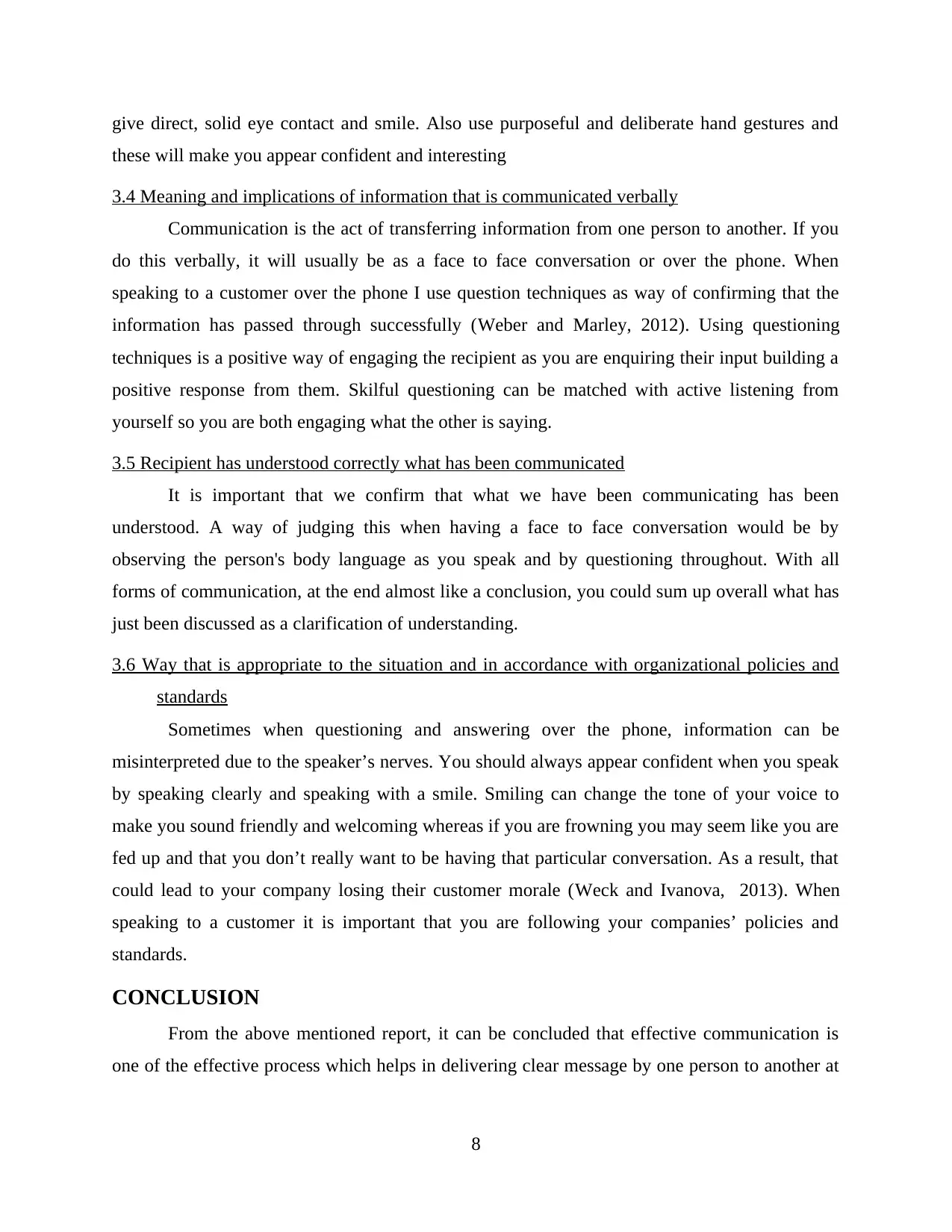
give direct, solid eye contact and smile. Also use purposeful and deliberate hand gestures and
these will make you appear confident and interesting
3.4 Meaning and implications of information that is communicated verbally
Communication is the act of transferring information from one person to another. If you
do this verbally, it will usually be as a face to face conversation or over the phone. When
speaking to a customer over the phone I use question techniques as way of confirming that the
information has passed through successfully (Weber and Marley, 2012). Using questioning
techniques is a positive way of engaging the recipient as you are enquiring their input building a
positive response from them. Skilful questioning can be matched with active listening from
yourself so you are both engaging what the other is saying.
3.5 Recipient has understood correctly what has been communicated
It is important that we confirm that what we have been communicating has been
understood. A way of judging this when having a face to face conversation would be by
observing the person's body language as you speak and by questioning throughout. With all
forms of communication, at the end almost like a conclusion, you could sum up overall what has
just been discussed as a clarification of understanding.
3.6 Way that is appropriate to the situation and in accordance with organizational policies and
standards
Sometimes when questioning and answering over the phone, information can be
misinterpreted due to the speaker’s nerves. You should always appear confident when you speak
by speaking clearly and speaking with a smile. Smiling can change the tone of your voice to
make you sound friendly and welcoming whereas if you are frowning you may seem like you are
fed up and that you don’t really want to be having that particular conversation. As a result, that
could lead to your company losing their customer morale (Weck and Ivanova, 2013). When
speaking to a customer it is important that you are following your companies’ policies and
standards.
CONCLUSION
From the above mentioned report, it can be concluded that effective communication is
one of the effective process which helps in delivering clear message by one person to another at
8
these will make you appear confident and interesting
3.4 Meaning and implications of information that is communicated verbally
Communication is the act of transferring information from one person to another. If you
do this verbally, it will usually be as a face to face conversation or over the phone. When
speaking to a customer over the phone I use question techniques as way of confirming that the
information has passed through successfully (Weber and Marley, 2012). Using questioning
techniques is a positive way of engaging the recipient as you are enquiring their input building a
positive response from them. Skilful questioning can be matched with active listening from
yourself so you are both engaging what the other is saying.
3.5 Recipient has understood correctly what has been communicated
It is important that we confirm that what we have been communicating has been
understood. A way of judging this when having a face to face conversation would be by
observing the person's body language as you speak and by questioning throughout. With all
forms of communication, at the end almost like a conclusion, you could sum up overall what has
just been discussed as a clarification of understanding.
3.6 Way that is appropriate to the situation and in accordance with organizational policies and
standards
Sometimes when questioning and answering over the phone, information can be
misinterpreted due to the speaker’s nerves. You should always appear confident when you speak
by speaking clearly and speaking with a smile. Smiling can change the tone of your voice to
make you sound friendly and welcoming whereas if you are frowning you may seem like you are
fed up and that you don’t really want to be having that particular conversation. As a result, that
could lead to your company losing their customer morale (Weck and Ivanova, 2013). When
speaking to a customer it is important that you are following your companies’ policies and
standards.
CONCLUSION
From the above mentioned report, it can be concluded that effective communication is
one of the effective process which helps in delivering clear message by one person to another at
8
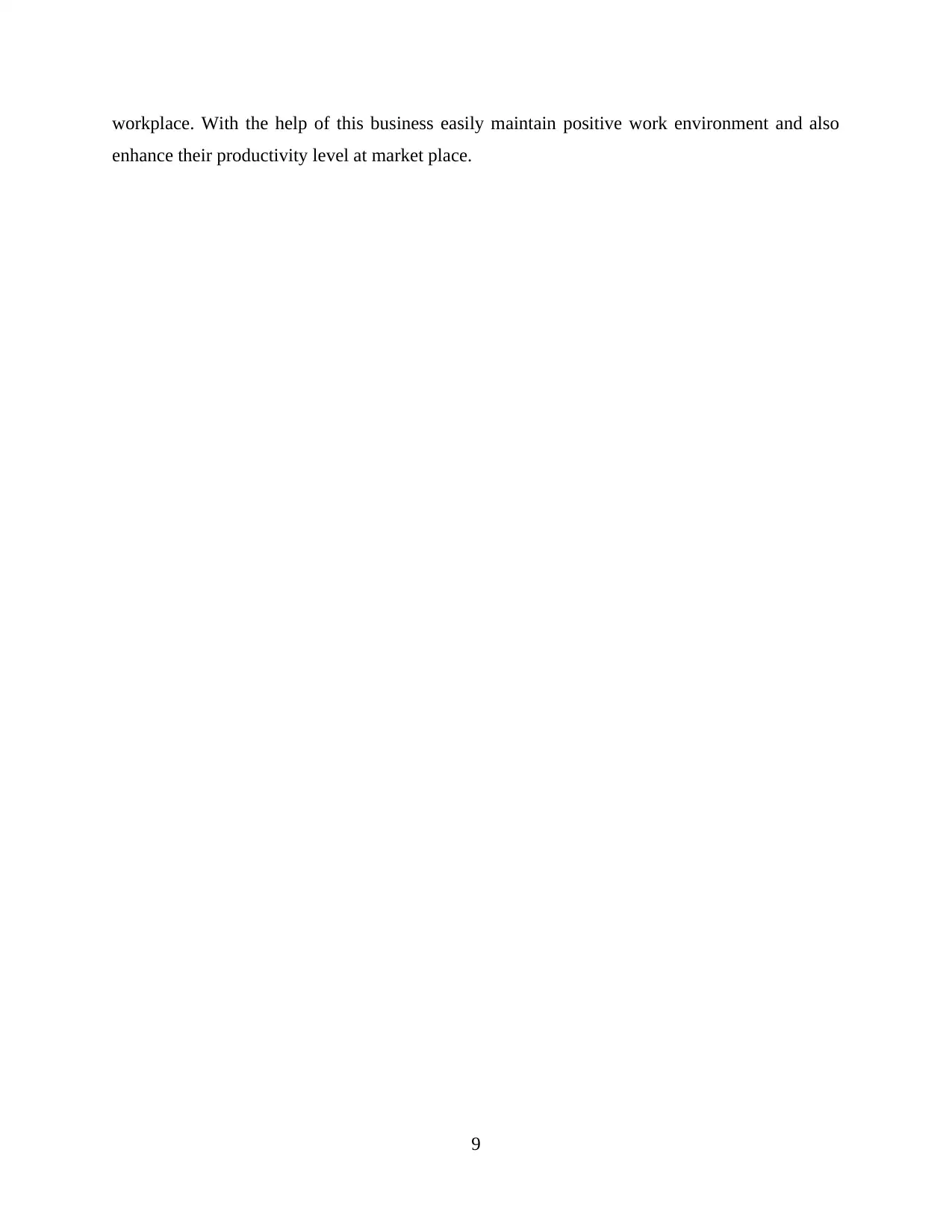
workplace. With the help of this business easily maintain positive work environment and also
enhance their productivity level at market place.
9
enhance their productivity level at market place.
9
⊘ This is a preview!⊘
Do you want full access?
Subscribe today to unlock all pages.

Trusted by 1+ million students worldwide
1 out of 13
Related Documents
Your All-in-One AI-Powered Toolkit for Academic Success.
+13062052269
info@desklib.com
Available 24*7 on WhatsApp / Email
![[object Object]](/_next/static/media/star-bottom.7253800d.svg)
Unlock your academic potential
Copyright © 2020–2025 A2Z Services. All Rights Reserved. Developed and managed by ZUCOL.





